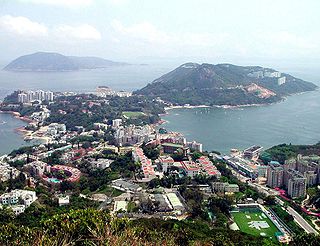
Stanley, or Chek Chue, is a coastal town and a popular tourist attraction in Hong Kong. It is located on a peninsula on Hong Kong Island. It is east of Repulse Bay and west of Shek O, adjacent to Chung Hom Kok and Tai Tam. Administratively, it is part of the Southern District.

Sham Shui Po is an area of Kowloon, Hong Kong, situated in the northwestern part of the Kowloon Peninsula, north of Tai Kok Tsui, east of Cheung Sha Wan and south of Shek Kip Mei (石硤尾). It is located in and is the namesake of the Sham Shui Po District.

The Shing Mun River or Shing Mun River Channel is a river in Sha Tin, Hong Kong.

Mid-Levels is an affluent residential area on Hong Kong Island in Hong Kong. It is located between Victoria Peak and Central. Residents are predominantly more affluent Hong Kong locals and expatriate professionals.
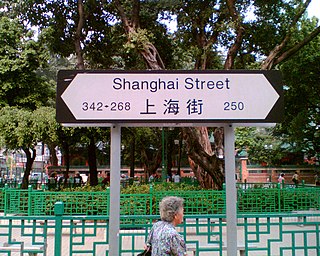
Shanghai Street is a 2.3 km long street in the Jordan, Yau Ma Tei and Mong Kok areas of Kowloon, Hong Kong, China. Completed in 1887 under the name of Station Street (差館街), it was once the most prosperous street in Kowloon. It originates from the south at Austin Road, and terminates in the north at Lai Chi Kok Road. Parallel to Shanghai Street are Nathan Road, Temple Street, Portland Street, Reclamation Street and Canton Road. Though parallel, Shanghai Street was marked by 2- to 3-floor Chinese-style buildings while Nathan Road was marked by Western-style buildings.
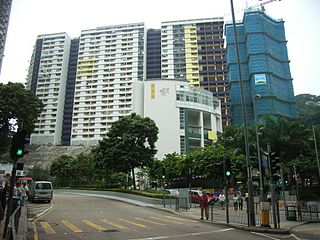
Kwun Lung Lau is a public housing estate in Kennedy Town, Hong Kong. It is one of the first public housing developments in Hong Kong, built in 1967 to alleviate a housing crisis in the territory. It is on 20 Lung Wah Street.

Ching Cheung Road, part of the Route 7, is a dual carriageway in New Kowloon, Hong Kong linking Lung Cheung Road and Tai Po Road near Tai Wo Ping and Kwai Chung Road of Route 5 near Lai Chi Kok, varying between 2+2 lanes and 3+4 lanes for its length. This road was named in honour of Sir David Trench, the Governor of Hong Kong when it was finished, and the road's name was derived from the connection of his Chinese name (戴麟趾) and the proverb “麟趾呈祥”.

Bonham Road is a main road in West Mid-Levels, Hong Kong Island in Hong Kong, running mainly East-West. The road connects Pok Fu Lam Road in the west, near the University of Hong Kong, and Caine Road in the east, at the junction with Hospital Road and Seymour Road. It was named after Sir George Bonham, the third Governor of Hong Kong. It was renamed Nishi-Taisho Dori (西大正通) during Japanese occupation of Hong Kong.
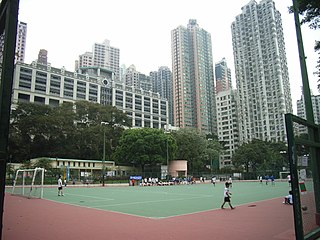
King George V Memorial Park, Hong Kong is an urban park in Sai Ying Pun and one of the few parks in Hong Kong bearing the former colonial links to the territory's past.

Blue House refers to a 4-storey balcony-type tenement block located at 72-74A Stone Nullah Lane, Wan Chai, Hong Kong. It is named after the blue colour painted on its external walls. It is one of the few remaining examples of tong lau of the balcony type in Hong Kong and is listed as a Grade I historic building.

East Kowloon Corridor is a motorway in Kowloon, Hong Kong. Part of Route 5, it is a dual two-lane carriageway viaduct running from the western exit of Kai Tak Tunnel near Sung Wong Toi Road to its ramp on Chatham Road North between Lo Lung Hang Hill and the western side of Hung Hom, to the northnortheast of Fat Kwong Street Flyover.
Articles related to Hong Kong include:

Stone Nullah Lane is a one-way street in Wan Chai, Hong Kong Island, Hong Kong. Named after the water channel that until 1959 ran down its middle, it stretches from Lung On Street to Queen's Road East. The street is noted for its historical landmarks, most notably the Blue House and Wan Chai Pak Tai Temple.
The Wan Chai Heritage Trail is a walking trail in Hong Kong. It was launched on 27 September 2009 and is two hours in duration. It was formed by the Old Wan Chai Revitalisation Initiatives Special Committee (OWCRISC) established by the Development Bureau to promote the local culture, history and architectural style of Wan Chai District.

The Kai Tak Nullah is a nullah or watercourse that collects water from the rivers and streams flowing from the hills in northern New Kowloon. It empties into a narrow channel leading into the Kwun Tong Typhoon Shelter. Part of the nullah is covered by roads and other facilities.

In Hong Kong there are a few types of graffiti that are utilized for different reasons. The face of artist Ai Weiwei is one of the more well-known caricatures in the region. Journalist and commentators have considered the graffiti as "street-art", "creative" and the "voice of the young".
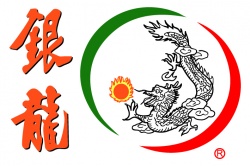
Ngan Lung Catering (Holdings) Limited is a cha chaan teng restaurant chain founded by Lau Choi Lung in 1963 in Hong Kong. The chain currently has 18 locations, primarily serving Kowloon and the New Territories. It also operates three restaurants on Hong Kong Island. Food items offered at each outlet varies, although most of the available food choices are standard, and are reminiscent of Hong Kong traditional cha chaan teng and bing sutt food culture.

Heung Yuen Wai Highway, also abbreviated as HYWH, is a controlled-access highway in North District, New Territories, Hong Kong. It diverges from Fanling Highway of Route 9 at Kau Lung Hang, crosses Sha Tau Kok Road and connects to Heung Yuen Wai Control Point, a border checkpoint between Hong Kong and China which opened for freight traffic on 26 August 2020.
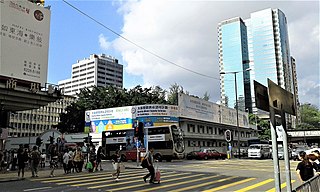
The Argyle Street Waterworks Depot was a building of the Water Supplies Department located in Mong Kok, Yau Tsim Mong District, Hong Kong.

















